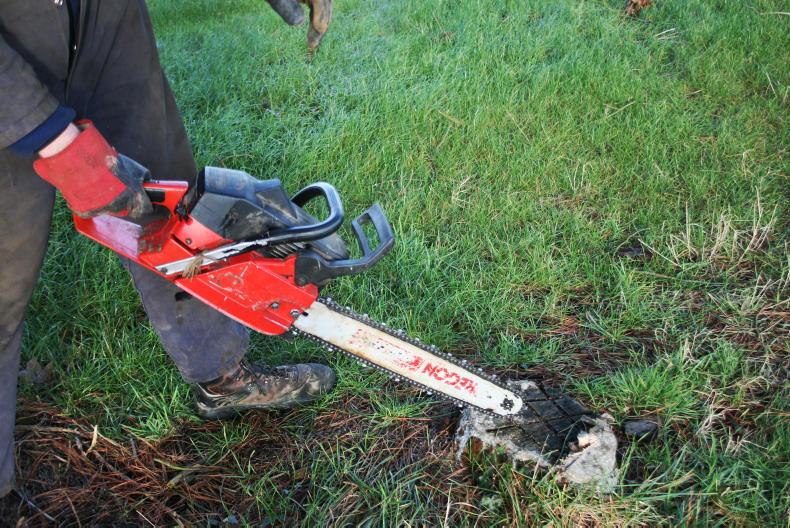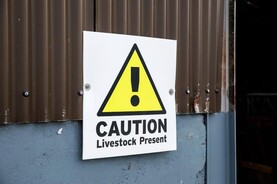Keep the right grip
Keep a steady grip on both handles on the saw. Thumbs and fingers must be completely wrapped around the handles. It is very important to hold the thumb of your left hand under the front handle in order to reduce the force of a possible kickback.
The boxer’s stance
Stand with your feet apart. To achieve the best possible balance, put your left foot slightly in front of your right foot.
Mind your back
Spare your back. Do not work with a curved spine. Bend your knees instead when working in low positions.
Hold the saw close
Do not be afraid of the saw. Hold it close to your body for better balance and to make the saw feel lighter. Also, make sure that no one is closer than 3m to 5m of you when working with a chainsaw. During tree felling, a greater safety distance is required
Transport
The chain must not be rotating when you are moving to another spot. When moving in several steps, you should activate the chain brake or turn off the engine. When you move a longer distance (eg to and from the felling site) or when transporting the chainsaw, you should fit the guide bar guard.
Beware of kickback
Kickback can occur during most work procedures if the saw is not handled carefully. This is why it is essential to learn and use the correct saw technique. Always use a chainsaw with a working chain brake. Thumbs and fingers must be completely wrapped around the handles. Always keep your left thumb under the front handle to catch the saw in case of kickback. The kickback zone is the upper part of the nose of the guide bar. Applying the guide bar here has a kickback risk. Never saw using the part of the guide bar that poses a significant risk for kickback. In the event of kickback, the chain will grip the timber with the kickback zone first. The saw and blade are thrown back and up by the force of the rotating chain.
The right way to tackle tree cutting near electricity wiresArthur Byrne of
ESB Networks on
electrical risks when using a
chainsaw to
cut trees
Do you know what can go wrong?
Imagine cutting a tree and watching as it catches the electricity wires and brings them to the ground. There may be no fireworks, only a few sparks accompanied by a faint burning smell. Look around and you may see someone lying quite still on the ground.
What do you think happened?
Electricity wires are always live and extremely dangerous to touch, or come too close to.
When electricity wires come to the ground, the area for 5m around the fallen wire is electrified, and extremely hazardous. Timber conducts electricity and there have been fatal accidents where the person cutting the tree was electrocuted because the timber he was cutting brushed off the wires.
Always plan the work and assess the risk where there are wires and poles nearby. If there is even the slightest risk, contact the ESB Networks emergency number 1850-372 999 for help.
The wires may have to be disconnected so that tree cutting can be carried out safely.
When cutting trees you should always keep yourself and the machinery you are using at least 3m away from overhead wires. This zone applies to any falling timber and any tools and equipment you are using.
Read more from our chainsaw focus
Getting the right chainsaw for the job
Head to head: STIHL versus Husqvarna
The new STIHL compact battery chainsaw
More than just a chainsaw for some
Is battery power the future for the chainsaw?
Keep the right grip
Keep a steady grip on both handles on the saw. Thumbs and fingers must be completely wrapped around the handles. It is very important to hold the thumb of your left hand under the front handle in order to reduce the force of a possible kickback.
The boxer’s stance
Stand with your feet apart. To achieve the best possible balance, put your left foot slightly in front of your right foot.
Mind your back
Spare your back. Do not work with a curved spine. Bend your knees instead when working in low positions.
Hold the saw close
Do not be afraid of the saw. Hold it close to your body for better balance and to make the saw feel lighter. Also, make sure that no one is closer than 3m to 5m of you when working with a chainsaw. During tree felling, a greater safety distance is required
Transport
The chain must not be rotating when you are moving to another spot. When moving in several steps, you should activate the chain brake or turn off the engine. When you move a longer distance (eg to and from the felling site) or when transporting the chainsaw, you should fit the guide bar guard.
Beware of kickback
Kickback can occur during most work procedures if the saw is not handled carefully. This is why it is essential to learn and use the correct saw technique. Always use a chainsaw with a working chain brake. Thumbs and fingers must be completely wrapped around the handles. Always keep your left thumb under the front handle to catch the saw in case of kickback. The kickback zone is the upper part of the nose of the guide bar. Applying the guide bar here has a kickback risk. Never saw using the part of the guide bar that poses a significant risk for kickback. In the event of kickback, the chain will grip the timber with the kickback zone first. The saw and blade are thrown back and up by the force of the rotating chain.
The right way to tackle tree cutting near electricity wiresArthur Byrne of
ESB Networks on
electrical risks when using a
chainsaw to
cut trees
Do you know what can go wrong?
Imagine cutting a tree and watching as it catches the electricity wires and brings them to the ground. There may be no fireworks, only a few sparks accompanied by a faint burning smell. Look around and you may see someone lying quite still on the ground.
What do you think happened?
Electricity wires are always live and extremely dangerous to touch, or come too close to.
When electricity wires come to the ground, the area for 5m around the fallen wire is electrified, and extremely hazardous. Timber conducts electricity and there have been fatal accidents where the person cutting the tree was electrocuted because the timber he was cutting brushed off the wires.
Always plan the work and assess the risk where there are wires and poles nearby. If there is even the slightest risk, contact the ESB Networks emergency number 1850-372 999 for help.
The wires may have to be disconnected so that tree cutting can be carried out safely.
When cutting trees you should always keep yourself and the machinery you are using at least 3m away from overhead wires. This zone applies to any falling timber and any tools and equipment you are using.
Read more from our chainsaw focus
Getting the right chainsaw for the job
Head to head: STIHL versus Husqvarna
The new STIHL compact battery chainsaw
More than just a chainsaw for some
Is battery power the future for the chainsaw?







 This is a subscriber-only article
This is a subscriber-only article












SHARING OPTIONS: